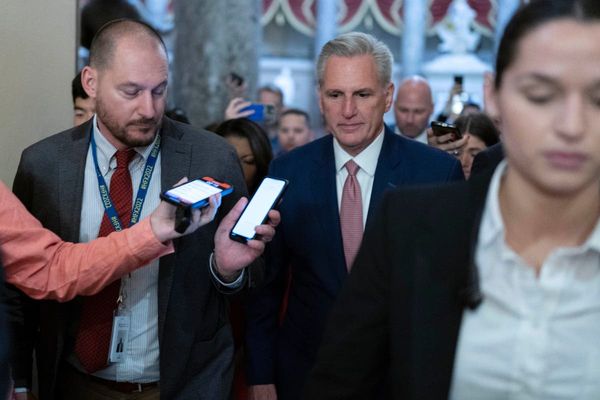
With the official end of the COVID-19 public health emergency, in May the federal government rolled back nearly all benefits that were broadened in 2020 to accommodate the waves of newly sick and financially vulnerable. Now those suffering from long COVID could lose supplemental income, food stamps and Medicaid just when they need it most.
People with long COVID, a catchall term for a wide range of often debilitating health problems potentially lasting long after an initial COVID infection, now face new barriers to accessing food or supplemental income. These requirements include filling out additional, complicated forms; providing medical documentation; and submitting to in-person interviews.
In the early days of the pandemic, many benefits were extended without the usual application steps and time limits. Medicaid recipients were guaranteed not to lose their coverage during the national public health emergency, a policy that led to a significant drop in the nation’s uninsured rate. With the end of the emergency declaration, Medicaid recipients must reapply for the health coverage, and up to 15 million could lose it over the next year, the government estimates.
Other vital federal aid programs besides Medicaid are returning to the stricter limits and requirements in place prior to the pandemic.
Funds for the federal food stamp program known as SNAP (Supplemental Nutrition Assistance Program) ended March 1 in 32 states and the District of Columbia, reducing monthly payments for about 32 million people. SNAP pays recipients an average of $6 per person per day.
One out of 10 people continue to suffer from long COVID after an initial infection with the Omicron variant, including mild and asymptomatic cases.
People needing direct cash assistance through TANF (Temporary Assistance for Needy Families) must prove their disability in order to be exempt from a work requirement, which can necessitate multiple tests and appointments with medical specialists. A report by the Center for Law and Social Policy documents additional renewed hurdles to accessing benefits. These requirements can be challenging for people with long COVID who are housebound, bedbound or unable to drive, according to Lisa McCorkell, co-founder of the Patient-Led Research Collaborative and contributor to the CLASP report.
“An in-person appointment can exacerbate symptoms, especially for severe [long COVID sufferers], including added cognitive dysfunction and brain fog,” McCorkell said. “Even filling out the forms can be extremely difficult, to stay on deadlines and give necessary documentation.”
Whitney Lee, a 29-year-old part-time disability rights consultant and long COVID patient in Utah, said SNAP has been a lifeline for her for more than two years. In February, Lee was surprised to learn that she missed a new cutoff for recertifying. She was able to reapply but meanwhile lost two months of benefits.
“Now [SNAP administrators] are sticklers about when you get paperwork in and they want that mailed, but I don’t have a printer,” she said. “[They require you] to go to a doctor to get the diagnostic tests, and you need transportation to go to the doctor.” Lee stopped driving when her COVID-related cognitive dysfunction led to two accidents. Utah also scuttled the extra $100 per month it provided to SNAP recipients during the pandemic. “Now costs are rising, so I have less money and food is more expensive,” she said.
Lee was already dealing with chronic illness, including fibromyalgia and chronic bronchitis, when a COVID infection in 2021 significantly worsened her health, and she hasn’t felt well since. She needs a portable oxygen concentrator for any amount of exertion — it was not covered by insurance, so her father bought her one — but nothing has helped her ongoing exhaustion and brain fog, and she’s able to work only about five hours a week. “Trying to get food or anything physically demanding can exhaust me, so I have to choose between something I enjoy, like walking the dog, or chores. Even showering some days is too exhausting.” Fortunately, Lee has subsidized housing, and she was able to remain on Medicaid for nearly three years while the continuous enrollment policy was in place. Her Medicaid enrollment will be up for review in the fall. “Now that the emergency is over, I think there is at least a chance I can lose Medicaid,” Lee wrote in an email.
“It’s quite shocking that we make people prove that they are disabled enough or poor enough to get health care.”~ Angela Vazquez, president, Body Politic
California is one of the few states that makes it easier for Medicaid recipients, who have to recertify only once a year. Most states, including Utah, require recipients to notify the agency any time their income or employment status changes. TANF, in most states, also requires immediate notification when there’s a change. California is also one of only 11 states that offer health coverage for undocumented residents (or in some states just children). California does it through its own budget rather than through federal matching funds.
Angela Vazquez, president of grassroots health justice organization Body Politic, worries that many long COVID patients, especially those such as essential workers who are at high risk of being reinfected, will lose access to Medicaid and other services that they still need, due to a “renewed culture of skepticism among county agencies reviewing benefits applications.”
According to a new study, one out of 10 people continue to suffer from long COVID after an initial infection with the Omicron variant — including mild and asymptomatic cases — and the rate of long COVID is even higher for people who are reinfected. Some long COVID patients recover, but many are now in their fourth year of debilitation.
Data from the U.S. Census Bureau show that Black and Hispanic adults, and those with lower income, are more likely to suffer from long COVID, and these adults are also more likely to suffer from food, housing and financial insecurity.
“Long COVID is a mass disabling event, and there are many folks who are newly disabled and newly low income,” Vazquez said. “Imagine being disabled and dependent on what coverage you can get from Medicaid providers, and now you have this task to prove you’re still poor enough for Medicaid. It’s quite shocking that we make people prove that they are disabled enough or poor enough to get health care.”
To Access Benefits, Prove You’re Disabled
As with those applying for disability insurance, many SNAP and TANF applicants must prove they are unable to work due to mental or physical disability. States have different standards for who’s considered disabled but all require diagnosis from doctors. If an applicant already has disability coverage, getting on SNAP or TANF is easier, but with the years-long wait times for processing disability applications, it’s unlikely someone with long COVID will currently be covered. And proving disability is challenging when there’s no single biomarker for long COVID and no reliable diagnostic tests for the disorder.
“Doctors who are not informed well on long COVID may say your tests are coming back normal,” McCorkell said. “Some doctors are not aware of the right tests to use and are not familiar with other post-viral syndromes like ME/CFS [myalgic encephalomyelitis/chronic fatigue syndrome], which has a huge overlap [with long COVID].”
Although the CDC has stopped tracking community levels and transmission rates of COVID-19, wastewater analysis shows continued widespread transmission.
McCorkell and other advocates recommend that the Department of Health and Human Services give states guidance to add long COVID to the list of qualifying disabilities for exemptions to work requirements for both SNAP and TANF. They also recommend reducing the administrative burden by requiring only a single application for all services, as California does. Ideally, McCorkell said, there would be federal funding to help people fill out applications, which often ask the same questions in different and confusing ways.
Eliminating in-person interviews is crucial, disability advocates say, especially when phone and conference calls were the norm for three years. People with long COVID are at high risk of reinfection, and possibly greater disability, when forced to be in public spaces that have scrapped all virus mitigation.
There may be long odds of retaining relatively easy access to benefits in a political environment where Republicans want to further restrict access. Although President Biden’s budget calls for “eliminating barriers to food assistance for vulnerable groups,” House Republicans are demanding additional restrictions to SNAP, including a work requirement, as well as clawing back remaining COVID funds, in the debt limit standoff. Republicans also want new work requirements for Medicare, Medicaid and social security.
The End of the Beginning
It’s not just the U.S. dismantling its pandemic scaffolding. On May 5 the World Health Organization declared an end to the “public health emergency of international concern” and recommended a global transition to “long-term management of the COVID-19 pandemic.”
But in the U.S. it is now harder to simply know the risk of contracting COVID and long COVID. The Centers for Disease Control has stopped tracking community levels and transmission rates of COVID-19. At-home testing is no longer free, presenting yet another barrier for poor and uninsured Americans. Although government data are harder to come by, wastewater analysis shows continued widespread transmission, meaning COVID, and long COVID, will continue.
In early 2021 COVID was killing 3,000 Americans per day, but as the national emergency was lifted on May 11, deaths were about a fifth of that. Death, however, isn’t the only metric of concern. Even for those younger, healthy and vaccinated, a “mild” COVID infection can lead to a life altering illness, regardless of age, comorbidities or vaccination status. COVID impacts nearly every organ in the body, and currently, there are no effective treatments. The virus continues evolving to find new ways to evade immunity, and there’s apparently no limit to the number of infections a person can have. The White House recently received a sobering report about the possibility of a newer variant that could cause mass infections to come roaring back.
Advocates for long COVID patients have decried the ending of the national emergency, not only because of the scaling back of benefits but for the message that it sends: that the pandemic is over and there’s no need to be careful.
“Early on, [government] messaging was, ‘Protect loved ones, the elderly, the immunocompromised,’” Vazquez said. “But now the message is personal choice. Even though the risk of getting infected is not individual but community driven. Everyone is at risk of long COVID, and each infection puts you at more risk of developing long COVID. It’s increasingly dangerous to be disabled and high risk in the U.S.”










